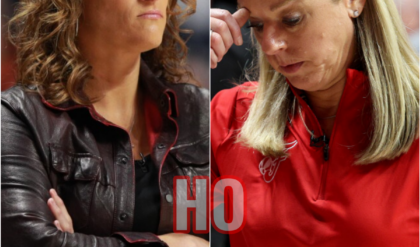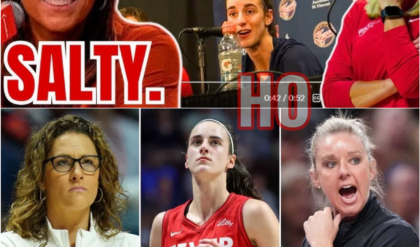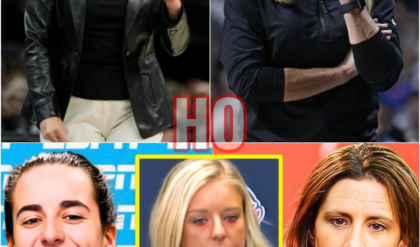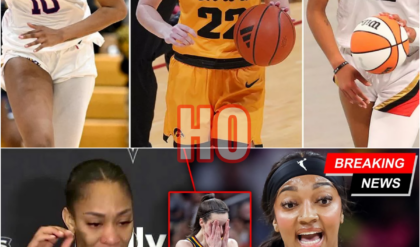SHOCKING WNBA TRAINWRECK EXPOSED by JUST RELEASED Playoff Ratings Without Caitlin Clark! | HO

The WNBA playoffs have hit a significant roadblock in 2024. Once riding high on unprecedented ratings and fan engagement, the league has suddenly found itself facing a massive decline in viewership. The cause? The absence of rookie sensation Caitlin Clark, whose early playoff elimination with the Indiana Fever has sent shockwaves through the league. With playoff ratings now a fraction of what they were during the regular season, the WNBA is facing a potential crisis. Let’s break down why Clark’s absence is so impactful, how the league is grappling with this challenge, and what it means for the future of women’s basketball.
Caitlin Clark took the WNBA by storm in 2024, a year many are calling the “Clark Revolution.” As a rookie, she didn’t just live up to the hype — she shattered expectations. Clark led the league in assists, set a rookie record for three-pointers, and quickly became the face of the WNBA. Fans flocked to see her play, and her games consistently drew significantly higher TV ratings. In fact, regular season games featuring Clark averaged 1.78 million viewers, a nearly 70% increase compared to games without her.
Clark’s impact wasn’t just about TV numbers. Her jerseys became the top-selling rookie jerseys in WNBA history. She drove ticket sales and merchandise purchases, and her energy on the court attracted a new, broader fanbase to women’s basketball. The Indiana Fever, her team, had the highest total attendance in the league, and her playoff games drew viewership peaks of 3.4 million, unheard of numbers for the WNBA.
Everything was set for a massive playoff run that could have continued boosting the league’s profile. But when the Indiana Fever were eliminated early by the Connecticut Sun, the WNBA’s ratings took a nosedive. Game 1 of the Liberty vs. Aces semifinals brought in only 929,000 viewers, less than 30% of what Clark’s Fever-Sun Game 2 playoff matchup had pulled in. And it didn’t stop there. Game 1 of the Sun vs. Lynx semifinals dropped to a dismal 650,000 viewers.
These numbers expose a glaring vulnerability in the league: over-reliance on a single player for drawing in viewership. The moment Clark was out of the picture, so too were many of the fans. ESPN has even begun to shift some games to ESPN2, indicating they’re expecting lower demand.

What makes Clark’s absence such a ratings catastrophe? The answer lies in her unique ability to engage audiences. Her dynamic playstyle, coupled with her ability to score from anywhere on the court and her leadership, made her a must-watch player. Fans, both new and old, tuned in not just for the Fever, but specifically to see Clark perform. She brought a level of excitement and energy that the WNBA desperately needed, elevating the entire league’s profile.
There’s also an element of controversy that surrounds Clark. Throughout the season, she was involved in several dramatic moments, including a highly publicized eye-poke incident during the playoffs, where she took a hit that went uncalled by the referees. This sparked outrage from fans and analysts alike and raised concerns about player safety and officiating in the WNBA. Clark also drew a disproportionate number of flagrant fouls, leading some to believe she was being unfairly targeted by opponents.
These controversies, while troubling, only added to her mystique. Fans loved to rally behind Clark, whether it was to support her on-court brilliance or to protest the perceived injustices she faced. With Clark out, much of that drama and emotional investment has disappeared, leaving the remaining playoff games feeling flat by comparison.
The WNBA’s mishandling of Clark’s rise to stardom has further compounded the problem. After breaking records and revitalizing interest in the league, Clark was named Rookie of the Year — but instead of a grand celebration, the league made the announcement over a phone call. No press conference, no ceremony in front of fans. This left many scratching their heads and wondering why the WNBA wouldn’t capitalize on the opportunity to highlight their brightest new star.
Additionally, Clark’s eye-poke incident exposed deeper issues within the league’s officiating and player safety protocols. The lack of a foul call on such a dangerous play led to questions about how well the WNBA protects its players. If the league can’t ensure that its top talent is safe on the court, how can it expect to grow?
These are the kinds of issues that alienate fans. When they feel that their favorite players aren’t being treated fairly or respectfully, they lose interest. Clark’s early exit has not only cost the WNBA in terms of ratings, but it has also spotlighted the league’s shortcomings in player protection and fan engagement.
The WNBA now faces a crucial test. Without Clark, the league must find ways to maintain the interest she generated. This could involve better marketing of other star players or focusing on team-based rivalries instead of relying on individual players to carry the load. But these fixes won’t be easy. The playoffs have already seen a significant drop in ratings, and if things don’t change quickly, the WNBA could lose the momentum it built during the regular season.
One of the biggest challenges will be balancing the need for star power with the overall health of the league. While Caitlin Clark undeniably brought in viewers, the WNBA cannot afford to become overly dependent on any one player. As Commissioner Cathy Engelbert pointed out, “No league is ever about one player.” But the reality is that Clark’s impact has been outsized, and her absence has revealed how fragile the WNBA’s newfound popularity really is.
The league must also address the officiating issues that have plagued this season. Fans want to see fair competition, and they expect their favorite players to be protected. The Clark eye-poke incident is a stark reminder that player safety needs to be a top priority.
The WNBA has entered uncharted waters. Caitlin Clark’s early playoff exit has not just hurt the Fever — it’s left a gaping hole in the league’s viewership. The ratings freefall is a clear indication that the league must find new ways to engage fans and grow the sport beyond the influence of a single player. If the WNBA can learn from this moment, invest in the safety and promotion of its players, and build a more sustainable model, it has the potential to continue its upward trajectory. But without swift action, the league risks losing the momentum that Caitlin Clark helped create.





